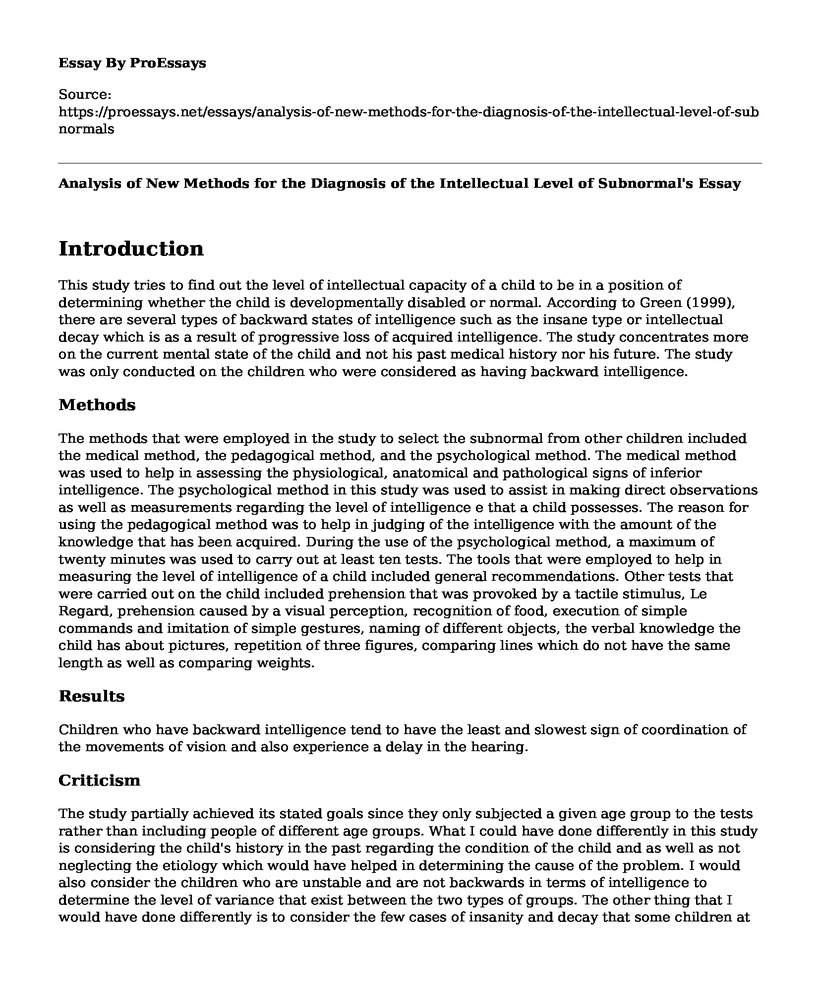Introduction
This study tries to find out the level of intellectual capacity of a child to be in a position of determining whether the child is developmentally disabled or normal. According to Green (1999), there are several types of backward states of intelligence such as the insane type or intellectual decay which is as a result of progressive loss of acquired intelligence. The study concentrates more on the current mental state of the child and not his past medical history nor his future. The study was only conducted on the children who were considered as having backward intelligence.
Methods
The methods that were employed in the study to select the subnormal from other children included the medical method, the pedagogical method, and the psychological method. The medical method was used to help in assessing the physiological, anatomical and pathological signs of inferior intelligence. The psychological method in this study was used to assist in making direct observations as well as measurements regarding the level of intelligence e that a child possesses. The reason for using the pedagogical method was to help in judging of the intelligence with the amount of the knowledge that has been acquired. During the use of the psychological method, a maximum of twenty minutes was used to carry out at least ten tests. The tools that were employed to help in measuring the level of intelligence of a child included general recommendations. Other tests that were carried out on the child included prehension that was provoked by a tactile stimulus, Le Regard, prehension caused by a visual perception, recognition of food, execution of simple commands and imitation of simple gestures, naming of different objects, the verbal knowledge the child has about pictures, repetition of three figures, comparing lines which do not have the same length as well as comparing weights.
Results
Children who have backward intelligence tend to have the least and slowest sign of coordination of the movements of vision and also experience a delay in the hearing.
Criticism
The study partially achieved its stated goals since they only subjected a given age group to the tests rather than including people of different age groups. What I could have done differently in this study is considering the child's history in the past regarding the condition of the child and as well as not neglecting the etiology which would have helped in determining the cause of the problem. I would also consider the children who are unstable and are not backwards in terms of intelligence to determine the level of variance that exist between the two types of groups. The other thing that I would have done differently is to consider the few cases of insanity and decay that some children at school could have considering it is also another form of backward intelligence. I would also conduct the study differently by ensuring I provide the possible solutions to the problem. The Study should have included other population and ages to determine if the condition persists or becomes less severe as one becomes older. The tests should be considered as being meaningful to us today since this is a condition that is being experienced across the world while some children are being born with the problem of backward intelligence.
Conclusion
The study helps us to understand the different ways that a child who is having a backward intelligence can be differentiated from other children. The study help as to understand that children who have backward intelligence are considered as being slow learners as compared to others. This study affects the science of psychology since it deals with finding out how children who have backward intelligence behave and studying their mind as well regarding reasoning. I think the reading was informative and educative as well as it equips the reader with the relevant knowledge of assessing whether a child could be suffering from the problem of backward intelligence.
References
Green, C. D. (1999). Classics in the history of psychology: An internet resource. Toronto: York University.
Cite this page
Analysis of New Methods for the Diagnosis of the Intellectual Level of Subnormal's. (2022, Mar 29). Retrieved from https://proessays.net/essays/analysis-of-new-methods-for-the-diagnosis-of-the-intellectual-level-of-subnormals
If you are the original author of this essay and no longer wish to have it published on the ProEssays website, please click below to request its removal:
- Lack of Sun Exposure Among Saudi Women Living in Canada
- Standardized Screening Tools for a 30 Months Old Child - Paper Example
- Comparative Studies of Ebola, Influenza, HIV and Zika Viruses Paper Example
- The Ethics of Euthanasia and Physician-Assisted Suicide Essay Example
- Essay Sample on Energy Drinks: Benefits, Risks and Alternatives
- Essay Sample on V.A. Hospital Scandal: Falsified Records & Secret Waiting List
- Essay Example on Nurse Burnout: Effects on Patient Outcomes







